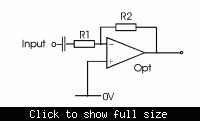Akramin84
Newbie level 6
question regarding opamp
i got mixed signal ac and dc, i just want to amplify ac signal so i put coupling capacitor to filter dc. the problem occur ac signal disappear when i connect to the non inverting pin of opamp. anyone can give me solution ????
i got mixed signal ac and dc, i just want to amplify ac signal so i put coupling capacitor to filter dc. the problem occur ac signal disappear when i connect to the non inverting pin of opamp. anyone can give me solution ????
